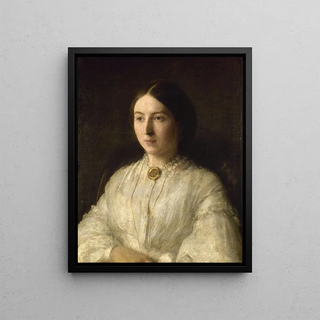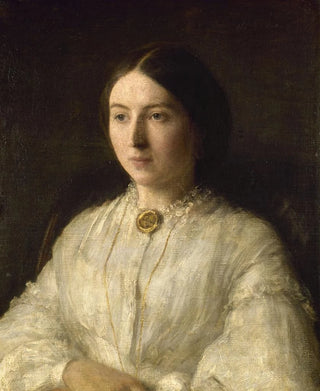Art print | Portrait of Mrs. Edwin Edwards - Henri Fantin-Latour


View from behind

Frame (optional)
In the world of art, some works transcend the simple frame of the canvas to become witnesses of an era, reflections of society. "Portrait of Mrs. Edwin Edwards" by Henri Fantin-Latour is one of those creations that captivate the eye and the mind. This portrait, created in 1885, embodies not only the technical virtuosity of the artist but also a deep understanding of human psychology. Through this painting, Fantin-Latour invites us to delve into the intimacy of his model, revealing nuances of character and emotion that still resonate today.
Style and uniqueness of the work
Fantin-Latour's style is distinguished by its delicate and refined approach. In "Portrait of Mrs. Edwin Edwards," the composition is carefully orchestrated, with each element chosen with precision that reflects the artist's expertise. The color palette, subtly nuanced, evokes an atmosphere that is both gentle and melancholic. The play of light and shadow gives Mrs. Edwards's figure an almost sculptural dimension, while the background, of remarkable simplicity, highlights the beauty of the subject. This portrait does not merely depict a woman; it captures an essence, a personality, as if each brushstroke were a note in a visual melody. Mrs. Edwards's posture, both elegant and natural, along with her contemplative gaze, demonstrates a psychological depth that invites the viewer to wonder about her story and thoughts.
The artist and his influence
Henri Fantin-Latour, an emblematic figure of the realist movement, profoundly marked the history of French art. Born in 1836, he managed to establish himself through his ability to combine academic tradition with modern sensitivity. His encounter with the Impressionists, although he never fully identified with this movement, enriched his work with new light and a freer approach to color. Fantin-Latour was also a great portraitist, his mastery of faces and human expressions being particularly recognized. Through "Portrait of Mrs. Edwin Edwards," he illustrates not only his talent but also his desire to capture

Matte finish

View from behind

Frame (optional)
In the world of art, some works transcend the simple frame of the canvas to become witnesses of an era, reflections of society. "Portrait of Mrs. Edwin Edwards" by Henri Fantin-Latour is one of those creations that captivate the eye and the mind. This portrait, created in 1885, embodies not only the technical virtuosity of the artist but also a deep understanding of human psychology. Through this painting, Fantin-Latour invites us to delve into the intimacy of his model, revealing nuances of character and emotion that still resonate today.
Style and uniqueness of the work
Fantin-Latour's style is distinguished by its delicate and refined approach. In "Portrait of Mrs. Edwin Edwards," the composition is carefully orchestrated, with each element chosen with precision that reflects the artist's expertise. The color palette, subtly nuanced, evokes an atmosphere that is both gentle and melancholic. The play of light and shadow gives Mrs. Edwards's figure an almost sculptural dimension, while the background, of remarkable simplicity, highlights the beauty of the subject. This portrait does not merely depict a woman; it captures an essence, a personality, as if each brushstroke were a note in a visual melody. Mrs. Edwards's posture, both elegant and natural, along with her contemplative gaze, demonstrates a psychological depth that invites the viewer to wonder about her story and thoughts.
The artist and his influence
Henri Fantin-Latour, an emblematic figure of the realist movement, profoundly marked the history of French art. Born in 1836, he managed to establish himself through his ability to combine academic tradition with modern sensitivity. His encounter with the Impressionists, although he never fully identified with this movement, enriched his work with new light and a freer approach to color. Fantin-Latour was also a great portraitist, his mastery of faces and human expressions being particularly recognized. Through "Portrait of Mrs. Edwin Edwards," he illustrates not only his talent but also his desire to capture






